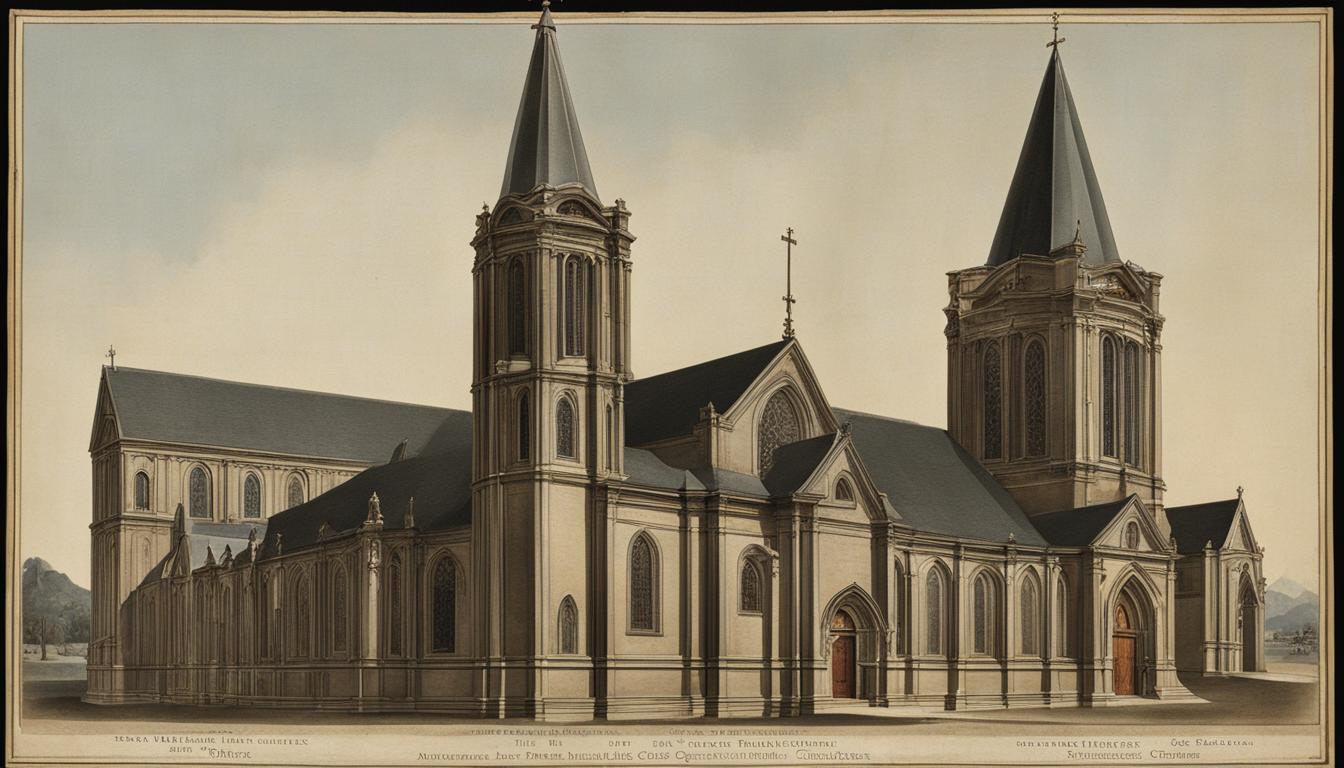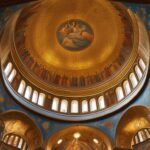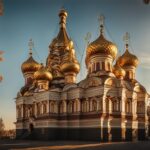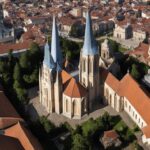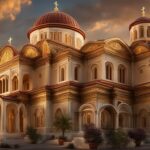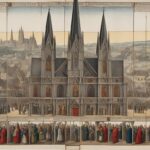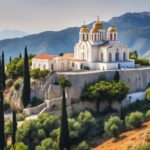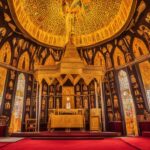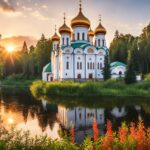The Great Schism, also known as the East-West Schism, was a significant split in Christianity that occurred in 1054, resulting in the emergence of two major branches of the religion: the Eastern Orthodox Church and the Roman Catholic Church. This division was rooted in political and theological differences between the Eastern and Western regions of Christianity.
Key Takeaways:
- The Great Schism occurred in 1054 and led to the formation of the Eastern Orthodox Church and the Roman Catholic Church.
- The division was caused by political and theological differences.
- The Eastern Orthodox Church operates under a decentralized structure, while the Roman Catholic Church has a centralized authority under the pope.
- Worship and celebration practices differ between the two branches.
- Efforts for reconciliation have been made over the centuries, but lasting unity remains elusive.
The Origins of Christianity
The origins of Christianity can be traced back to the teachings of Jesus Christ and his disciples. Jesus, believed by Christians to be the Son of God, preached love, compassion, and forgiveness. His message gained followers as he performed miracles and spread his teachings throughout the Roman Empire.
In the early years of Christianity, followers faced persecution from the Roman authorities who saw them as a threat to their power. Despite this opposition, the faith continued to grow, attracting individuals from various social backgrounds.
The Roman Empire played a crucial role in the spread of Christianity. Emperor Constantine’s Edict of Milan in 313 legalized Christianity, marking a significant turning point for the religion. By 380, it became the state religion, and its influence continued to expand throughout Europe.
The Teachings of Jesus Christ
“Love your enemies and pray for those who persecute you.” – Matthew 5:44
The early Christian community was organized under the guidance of bishops, who were appointed to lead and oversee local congregations. These bishops played a vital role in preserving and transmitting the teachings of the apostles, ensuring the continuity of the faith.
| Key Points | Early Christianity | Roman Empire | Bishops |
|---|---|---|---|
| Role | Spread of Jesus’ teachings | Legalization and state religion | Leadership and preservation of faith |
| Impact | Attracted followers despite persecution | Increased visibility and influence | Ensured continuity of teachings |
| Significance | Foundation of Christian faith | Promoted widespread adoption | Established hierarchical structure |
Understanding the origins of Christianity provides insights into the early formation of the religion and its subsequent impact on world history. The teachings of Jesus Christ, the Roman Empire’s role in its expansion, and the leadership of bishops were pivotal in shaping the faith into what it is today.
The East-West Schism
The East-West Schism was a significant division within Christianity that occurred in 1054, resulting in the separation of the Eastern Orthodox Church and the Roman Catholic Church. This split was primarily driven by deepening political and theological differences between the Eastern and Western regions of Christianity.
On the political front, the Byzantine Empire (representing the East) and the Holy Roman Empire (representing the West) held conflicting interests and often clashed over issues of authority and jurisdiction. The papacy in Rome claimed a position of supremacy over the entire Christian world, while the Byzantine Patriarch in Constantinople believed in a more decentralized approach.
Theological differences also played a significant role in the schism. One of the central points of contention was the inclusion of the Filioque clause in the Nicene Creed. This clause, added by the Western Church, stated that the Holy Spirit proceeds from both the Father “and the Son,” while the Eastern Church insisted on the original formulation that the Holy Spirit proceeds from the Father alone. This theological dispute symbolized deeper disagreements about the nature of God and the role of the Son.
| Political Differences | Theological Differences |
|---|---|
| Conflicting political interests between the Byzantine Empire and the Holy Roman Empire | Disagreement over the inclusion of the Filioque clause in the Nicene Creed |
| Clashes over authority and jurisdiction | Deeper theological divisions about the nature of God |
| Roman papacy asserted supremacy over the entire Christian world | Eastern Church insisted on a more decentralized approach |
The East-West Schism had far-reaching consequences for Christianity. It not only led to the emergence of two distinct branches of the faith but also contributed to the development of separate religious identities, liturgical practices, and ecclesiastical structures. Understanding this schism is crucial for grasping the diversity within Christianity and its complex historical evolution.
The Eastern Orthodox Church
The Eastern Orthodox Church, one of the major branches that emerged from the Great Schism, holds a unique structure and leadership within Christianity. Unlike the Roman Catholic Church, the Eastern Orthodox Church operates under a decentralized system. Each Orthodox church has its own head bishop and enjoys a level of autonomy in decision-making. The highest authority in the Eastern Orthodox Church is the Ecumenical Patriarch of Constantinople, who is regarded as the “first among equals” among the various bishops.
In terms of beliefs and practices, the Eastern Orthodox Church is known for its conservatism. It places a strong emphasis on tradition and symbolism in its worship. Liturgical services are rich in rituals and are conducted in a highly structured manner. Icons, religious paintings or images, play a significant role, serving as aids to prayer and contemplation. The Orthodox Church also upholds the veneration of saints, and their intercession is sought for spiritual guidance and assistance.
“Tradition is not the worship of ashes, but the preservation of fire.” – Gustav Mahler
The conservative nature of the Eastern Orthodox Church is reflected in its adherence to traditional doctrines and teachings. It maintains theological continuity with early Christianity and regards itself as the true custodian of the apostolic tradition. This commitment to tradition has preserved its distinct identity and has shaped its doctrinal, liturgical, and spiritual practices throughout history.
Table: Comparison of Structure in Eastern Orthodox Church and Roman Catholic Church
| Eastern Orthodox Church | Roman Catholic Church | |
|---|---|---|
| Structure | Decentralized | Centralized |
| Head Authority | Ecumenical Patriarch of Constantinople | Pope |
| Autonomy | Each church has its own head bishop | Hierarchical structure under the Pope |
| Decision-Making | Made collectively through the Holy Synod | Papal authority and councils |
This table provides a comparison of the structure of the Eastern Orthodox Church and the Roman Catholic Church, highlighting the key differences between the two branches.
Structure and Leadership of the Roman Catholic Church
The Roman Catholic Church is renowned for its hierarchical structure and centralized leadership under the pope. This structure enables the church to effectively govern its vast global community of believers, providing unity and guidance in matters of faith and doctrine. At the top of the church hierarchy sits the pope, who is considered the successor of Saint Peter and holds the highest authority within the Roman Catholic Church.
Under the pope, there is a network of cardinals, bishops, and priests who help administer the church at various levels. Cardinals are appointed by the pope and form the College of Cardinals, which is responsible for electing the new pope when the position becomes vacant. Bishops oversee individual dioceses and are responsible for the spiritual well-being of the faithful within their respective regions. Finally, priests serve as the primary spiritual leaders within local parishes, guiding and ministering to the needs of the congregation.
In terms of its beliefs and practices, the Roman Catholic Church is grounded in a rich tradition that encompasses both scripture and sacred tradition. The church upholds the belief in the Holy Trinity, the divinity of Jesus Christ, and the sacraments as essential components of the Christian faith. The sacraments, such as baptism, communion, and confession, play a central role in the spiritual life of Catholics, providing avenues for grace and forgiveness.
Table: Roman Catholic Church Hierarchy
| Position | Role |
|---|---|
| Pope | The highest authority and leader of the Roman Catholic Church. |
| Cardinals | Appointed by the pope and responsible for electing the new pope. |
| Bishops | Oversee individual dioceses and are responsible for spiritual well-being within their regions. |
| Priests | Primary spiritual leaders within local parishes, guiding and ministering to the congregation. |
One of the defining features of the Roman Catholic Church is the concept of papal authority. The pope is seen as the infallible interpreter of divine revelation and holds the power to make authoritative pronouncements on matters of faith and morals. This infallibility extends only to issues of doctrine and not to personal opinions or matters unrelated to faith.
Compared to the Eastern Orthodox Church, the Roman Catholic Church tends to hold more moderate views on social issues, engaging in dialogue and adaptation in response to societal changes. While the core beliefs and teachings align between the two traditions, differences exist in certain practices and interpretations. These distinctions contribute to the unique identity of the Roman Catholic Church within the broader scope of Christianity.
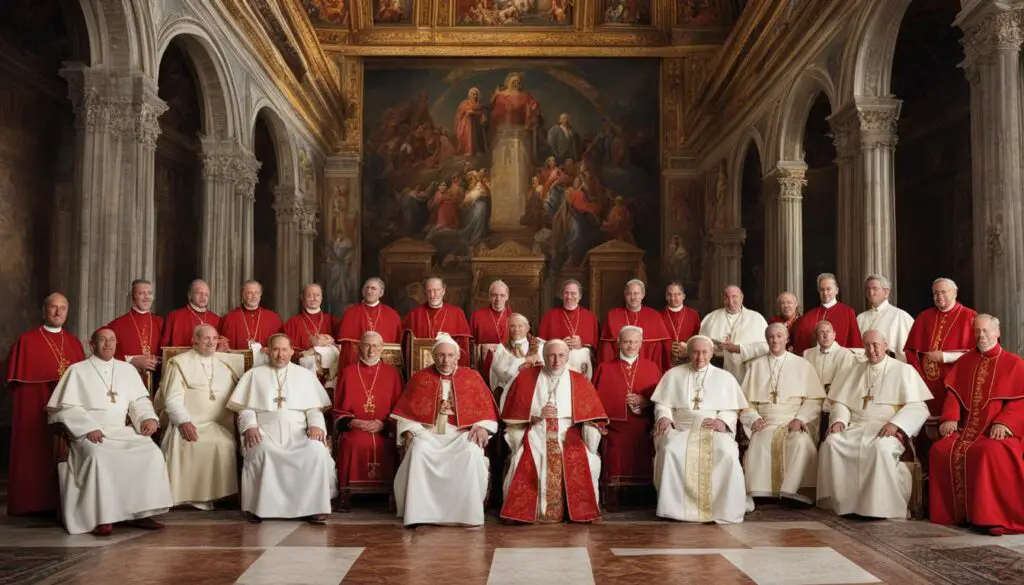
Differences in Worship and Celebrations
The East-West Schism resulted in distinct differences in worship and celebrations between the Eastern Orthodox Church and the Roman Catholic Church. These differences manifest in various aspects of religious practice, including the sign of the cross and Easter traditions.
Sign of the Cross
One notable difference in worship between the two traditions is the way they make the sign of the cross. In the Roman Catholic Church, the faithful make the sign of the cross from left to right, while in the Eastern Orthodox Church, it is done in the opposite direction, from right to left. This difference may seem insignificant to some, but it holds deep symbolic meaning within each tradition.
Easter Traditions
Easter, a significant event in Christianity, is also observed differently by the Eastern Orthodox Church and the Roman Catholic Church. Both traditions celebrate the resurrection of Jesus Christ, but there are variations in emphasis and symbolism surrounding His death and resurrection.
In the Eastern Orthodox Church, Easter is considered the most important feast of the liturgical year. It is celebrated with great solemnity and is known as Pascha. The Orthodox Easter typically falls on a different date than the Catholic Easter due to differences in calculating the date based on the Julian and Gregorian calendars. The Orthodox celebration includes a midnight liturgy, the procession of the resurrection icon, and the greeting “Christ is risen” exchanged among the faithful.
On the other hand, the Roman Catholic Church observes Easter with traditional Masses and liturgical rituals. The Catholic Easter Vigil is a significant ceremony held the night before Easter Sunday, culminating in the celebration of the resurrection. The liturgical colors, music, and prayers differ between the two traditions, reflecting the distinct cultural and spiritual expressions of each.
Table: Comparison of Easter Traditions in the Eastern Orthodox Church and the Roman Catholic Church
| Eastern Orthodox Church | Roman Catholic Church |
|---|---|
| Observed on a different date than Catholic Easter | Usually observed on the same date as Orthodox Easter |
| Pascha – midnight liturgy, procession of the resurrection icon | Easter Vigil – traditional Masses and liturgical rituals |
| Exchange of the greeting “Christ is risen” | Different liturgical colors, music, and prayers |
Afterlife Beliefs
The afterlife beliefs in the Eastern Orthodox Church and the Roman Catholic Church differ significantly. In the Eastern Orthodox Church, there is no belief in the concept of purgatory or the practice of indulgences. This branch of Christianity adheres to the original teachings and practices of early Christianity, emphasizing the importance of repentance and spiritual growth during one’s earthly life.
The Eastern Orthodox Church believes that after death, the souls of the faithful undergo a process of purification and preparation for union with God. This purification is seen as a transformative journey towards holiness, guided by divine grace. The focus is on the spiritual growth and purification of the soul, rather than a temporary state of punishment or the need for indulgences.
On the other hand, the Roman Catholic Church teaches the existence of purgatory, a state of temporary suffering and purification for souls who have died in a state of grace but are not yet fully ready for the beatific vision of heaven. According to Catholic doctrine, the souls in purgatory can benefit from the prayers and good works of the living and can also be aided by indulgences granted by the Church.
Table: Comparing Afterlife Beliefs
| Eastern Orthodox Church | Roman Catholic Church | |
|---|---|---|
| Belief in Purgatory | No | Yes |
| Belief in Indulgences | No | Yes |
| Focus on Spiritual Growth | Yes | Yes |
| Role of Prayers and Good Works | Emphasized | Emphasized |
The differing beliefs on the afterlife reflect the theological and doctrinal distinctions between the Eastern Orthodox Church and the Roman Catholic Church. While both traditions affirm the ultimate goal of union with God, they approach the process of reaching that goal in different ways.
It is important to note that these beliefs and practices are not exhaustive and may vary among individual believers within each tradition. The afterlife remains a mystery beyond human comprehension, and these teachings provide frameworks for understanding and spiritual guidance within their respective faith communities.
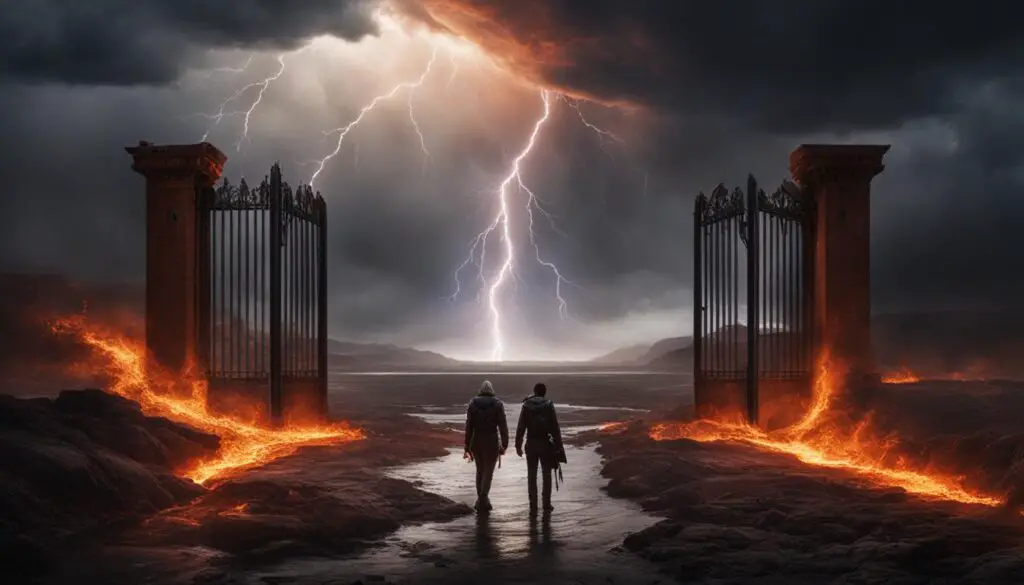
Modern Reforms and Controversies
In recent years, both the Eastern Orthodox Church and the Roman Catholic Church have been the center of discussions and debates surrounding potential reforms. These controversies have led to clashing views within each tradition, reflecting the diverse perspectives held by their members.
Orthodox Church Reform
The Eastern Orthodox Church, known for its conservative stance, has also witnessed calls for reform. Some Orthodox communities have considered changes such as openly spoken prayers during services, aiming to foster a greater connection between the clergy and the congregation. These proposed reforms seek to make the liturgy more inclusive and participatory, reflecting the evolving needs of the faithful.
Catholic Church Reform
The Roman Catholic Church, with its centralized structure and hierarchical authority, has also faced its share of internal debates and discussions. These conversations have touched upon various social issues, such as the role of women in the Church, reproductive rights, and the treatment of marginalized communities. Catholics with progressive views advocate for a more inclusive and compassionate approach, while traditionalists emphasize the preservation of long-standing doctrines and practices.
“Reforms within religious institutions are a natural part of their growth and evolution. However, the process can be challenging when members hold diverse perspectives, reflecting the complexities of the societies in which these churches exist,” said Dr. Elizabeth Thomas, a professor of Religious Studies.
These debates and discussions are not limited to the hierarchy of the churches but involve the collective voice of the faithful. Protest movements and advocacy groups have emerged, aiming to bring attention to the need for change and urging the respective churches to address pressing social and theological issues. These movements demonstrate the dynamism within religious communities and the continuous evolution of religious practices and beliefs.
| Eastern Orthodox Church | Roman Catholic Church | |
|---|---|---|
| Views on Reform | Some communities advocate for changes such as openly spoken prayers during services. | Debates center around issues such as the role of women, reproductive rights, and treatment of marginalized communities. |
| Approach | Seeking greater inclusivity and a participatory liturgy. | Balancing tradition and progressive values, emphasizing the preservation of long-standing doctrines and practices. |
| Impact | Reflects the evolving needs of the faithful and the desire for a more connected worship experience. | Addresses pressing social and theological issues to align the Church’s teachings with contemporary values. |
While these calls for reform have sparked passionate discussions and disagreements, they also reflect the ongoing vitality of these religious communities. The desire for change and the pursuit of a more inclusive and relevant religious experience reflect the constant evolution of Christianity as it adapts to the challenges and complexities of the modern world.
Efforts for Reconciliation
Throughout history, numerous attempts have been made to bridge the divide between the Eastern Orthodox Church and the Roman Catholic Church. These efforts for unity have aimed to mend the wounds of the Great Schism and foster greater understanding between the two traditions.
One notable example is the Council of Constance, which took place from 1414 to 1418. This ecumenical council brought together representatives from both the Eastern and Western Churches in an effort to resolve theological and political differences. Although the council achieved significant progress, ultimately resulting in the election of Pope Martin V and the end of the Avignon Papacy, lasting reconciliation was not achieved.
“The Council of Constance marked an important step forward in the journey towards unity between the Eastern Orthodox Church and the Roman Catholic Church. It was a time of dialogue, debate, and negotiation, but despite the efforts made, the two traditions remained divided. However, the Council of Constance laid the foundation for future ecumenical dialogues and set the stage for continued discussions on reconciliation.”
In the centuries that followed, ecumenical dialogues have continued to take place between representatives of the Eastern Orthodox Church and the Roman Catholic Church. These dialogues have sought to address theological differences, clarify misunderstandings, and explore avenues for unity.
The Joint International Commission for Theological Dialogue between the Orthodox Church and the Roman Catholic Church is one such ongoing initiative. This commission engages in theological discussions on topics of shared interest and strives to identify points of agreement and areas where further dialogue is needed. Through such efforts, the hope for unity and reconciliation remains alive.

Table: Council of Constance and Ecumenical Dialogues
| Council of Constance | Ecumenical Dialogues |
|---|---|
| 1414-1418 | Ongoing |
| Representatives from Eastern and Western Churches | Representatives from Eastern Orthodox Church and Roman Catholic Church |
| Addressed theological and political differences | Engages in theological discussions |
| Progress made, but lasting reconciliation not achieved | Seeks points of agreement and further dialogue |
Conclusion
The Great Schism of 1054 had a profound impact on the course of Christianity and its religious history. This significant split resulted in the emergence of two major branches, namely the Eastern Orthodox Church and the Roman Catholic Church, both of which have distinct beliefs, practices, and structures.
Understanding the complexities and nuances of this schism provides valuable insights into the diverse nature of Christianity and its historical development. The Eastern Orthodox Church operates under a decentralized structure, placing a strong emphasis on tradition and symbolism. On the other hand, the Roman Catholic Church has a centralized authority under the pope, embracing moderate views on social issues.
The differences in worship, celebrations, and afterlife beliefs between these two branches further highlight the lasting impact of the Great Schism. Efforts for reconciliation have been made over the centuries, but lasting unity has remained a challenge. Nevertheless, ongoing ecumenical dialogues and discussions continue to seek greater understanding and bridge the gap between these traditions.
FAQ
What is the Great Schism?
The Great Schism, also known as the East-West Schism, was a significant split in Christianity that occurred in 1054, resulting in the emergence of two major branches of the religion: the Eastern Orthodox Church and the Roman Catholic Church.
When did Christianity originate?
Christianity originated from the teachings of Jesus Christ and his disciples. After Jesus’ death and resurrection, Christianity began to spread throughout the Roman Empire, despite facing periods of persecution.
Why did the East-West Schism happen?
The East-West Schism was the result of deepening political and theological divisions between the Eastern and Western branches of Christianity. Disagreements on worship and doctrine, including the inclusion of the Filioque clause in the Nicene Creed, played a significant role in the schism.
What is the structure of the Eastern Orthodox Church?
The Eastern Orthodox Church operates under a decentralized structure. Each Orthodox church has its own head bishop, and decisions are made collectively through the Holy Synod.
What is the structure of the Roman Catholic Church?
The Roman Catholic Church has a centralized authority under the pope. The pope is seen as the successor of Saint Peter and is considered infallible when speaking on matters of faith and morals. The Catholic Church has a hierarchical structure with bishops and priests.
What are the differences in worship between the Eastern Orthodox Church and the Roman Catholic Church?
One notable difference is the direction of making the sign of the cross, with Catholics doing it from left to right and Orthodox Christians doing it the opposite way. Easter, a significant event in Christianity, is also observed differently by the two traditions with varying emphasis and symbolism surrounding Christ’s death and resurrection.
What are the afterlife beliefs of the Eastern Orthodox Church and the Roman Catholic Church?
The Eastern Orthodox Church does not believe in the concept of purgatory or the practice of indulgences. The Roman Catholic Church, on the other hand, has teachings on purgatory and offers indulgences as a means of obtaining forgiveness.
Have there been any reforms in the Orthodox and Catholic Churches?
In recent years, both the Eastern Orthodox Church and the Roman Catholic Church have experienced internal debates and discussions surrounding potential reforms. Some Orthodox communities have considered reforms such as openly spoken prayers during services, while the Catholic Church has seen debates on various social issues.
Have there been efforts to reconcile the Eastern Orthodox Church and the Roman Catholic Church?
Over the centuries, there have been efforts to heal the divide between the Eastern Orthodox Church and the Roman Catholic Church. The Council of Constance in 1414-1418 and the Council of Florence in 1438-1439 were notable attempts to bring about reconciliation, but lasting unity has proved elusive. Ecumenical dialogues and ongoing discussions continue in an effort to mend the divide.
What is the impact of the Great Schism on Christianity?
The Great Schism is a significant chapter in Christian history that shaped the course of Christianity and left a lasting impact. It resulted in the emergence of two major branches of the religion, the Eastern Orthodox Church and the Roman Catholic Church, each with its own distinct beliefs, practices, and structures.


